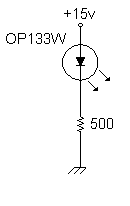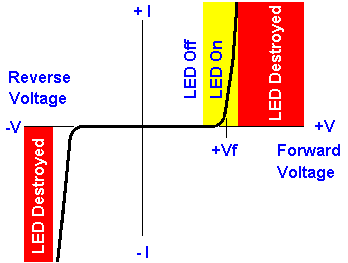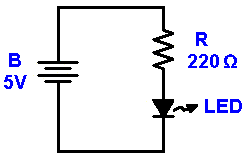
Magnetic Levitation
Levitation
- Introduction
- Why
- Other Maglev
- Hard Drive Maglev
- Schematic
- Parts List
- Buying Parts
- Woodworking
- Other's
- Photographs
- Infrared Emitter
- Photodetector
- Reference Det
- Difference Amp
- Feedback Loop
- Loop Equations
- Bode Plot
- Phase Lead
- Output Amp
- Coil Driver
- PWM
- Lifting Coil
- PSPICE
- Build Time
- PCB
- Power Supplies
- Setup
- Test Power
- Test IR Emitter
- Test Signal Det
- Test Ref Det
- Adjust Sensing Res
- Test Diff Amp
- Test Non-Invert Amp
- Test Coil Driver
- Test Lifting Coil
- Results
Designing the Infrared Emitter Circuit

The infrared LED emitter produces a light beam across the bottom of the coil.
We chose IR (infrared) because there's less noise and ambient light than at normal optical wavelengths. Later, I found plenty of ambient light sources that interfered with the light beam, most noticeably indirect sunshine from a nearby window made a big difference to the optodetector. It would probably work fine to use a visible LED instead, such as high-intensity red. It would even work with a flashlight bulb, which also make it much easier to see everytthing working inside the levitator's box.
Mount the whole assembly in a five-sided box type of frame, to eliminate ambient light from most directions. We want the LED to be the brightest light seen by the optodetectors. You will probably see an improvement if you put black paper around the emitter side of the box to reduce reflected light.
Choose a bias resistor for the LED to produce a healthy signal. I used 500 ohms, which yields a 30 mA current through the LED. That is, current is voltage divided by resistance, or approximately 15 volts divided by 500 ohms will yield about 30 mA.
Caution: With these values, the resistor will get hot! To avoid the chance of fire or injury, use a 2-watt or 3-watt resistor. Or, use several 1/4-watt resistors in parallel for an equivalent net resistance.
You want the LED bright enough to be well above "noise" sources. You don't want it too bright, or it will drive the optodetector into "on" saturation. (Though that's not likely to be a problem with a couple inches of separation to the detector.) You also don't want it too bright or it wastes power and produces heat, which may shorten its lifetime. Check the specifications for your own infrared LED and run it fairly hot, but don't overdrive it. Note the photodetectors from Radio Shack are quite sensitive, and you can probably use a 1K-ohm resistor successfully in place of the 500-ohm.
LED Characteristics
 Light
Emitting Diodes are silicon devices that produce light. The light is produced only when current
passes through in the forward direction. To produce light, the forward voltage must be higher
than the diode's internal barrier voltage. This point is labelled +Vf ("voltage forward")
on the graph.
Light
Emitting Diodes are silicon devices that produce light. The light is produced only when current
passes through in the forward direction. To produce light, the forward voltage must be higher
than the diode's internal barrier voltage. This point is labelled +Vf ("voltage forward")
on the graph.
Like any other diode, LEDs pass current in the forward direction, but block current in the reverse direction. This means the LED will only light up if connected with its cathode on the negative side of the circuit, and its anode on the positive side. Too much reverse voltage will destroy LEDs and diodes.
It is important to note that once the voltage across the LED reaches +Vf, the diode conducts current extremely well. This is shown by the sharp rise in the forward current (+I) indicated by the near vertical line. The LED can be easily destroyed by an excess of current.
 To
protect the LED, a series current limiting resistor is added, as shown in this figure.
To
protect the LED, a series current limiting resistor is added, as shown in this figure.
The cathode side is usually marked with a flag spot on the flage that rings the body of the diode. The cathode wire is also shorter than the anode wire. This figure compares an LED with its schematic symbol.
Designing With LED's
You could connect the LED to a 1K resistor, and it always works. However, the higher the voltage, the brighter the LED. How do you calculate the resistor in advance?
An LED has a nearly constant forward voltage. Regardless of the current, the LED will show about the same voltage across its terminals. (Try it with a voltmeter!)
What is "forward voltage"? It is the voltage from anode to cathode when the diode is in conduction.
How much forward voltage does an LED have? It depends on the LED, and typically ranges from 0.6v to 2.0v. Read your LED's specifications. For example, look at a typical LED from Radio Shack such as catalog number 276-143. What?! Their spec sheet does not show forward voltage or has nearly 2v forward voltage.
An LED is a diode. An LED is not a resistor, and the voltage does not divide proportional to resistance.
| < Previous | Page 11 of 37 | Next > |
©1998-2026 Barry Hansen